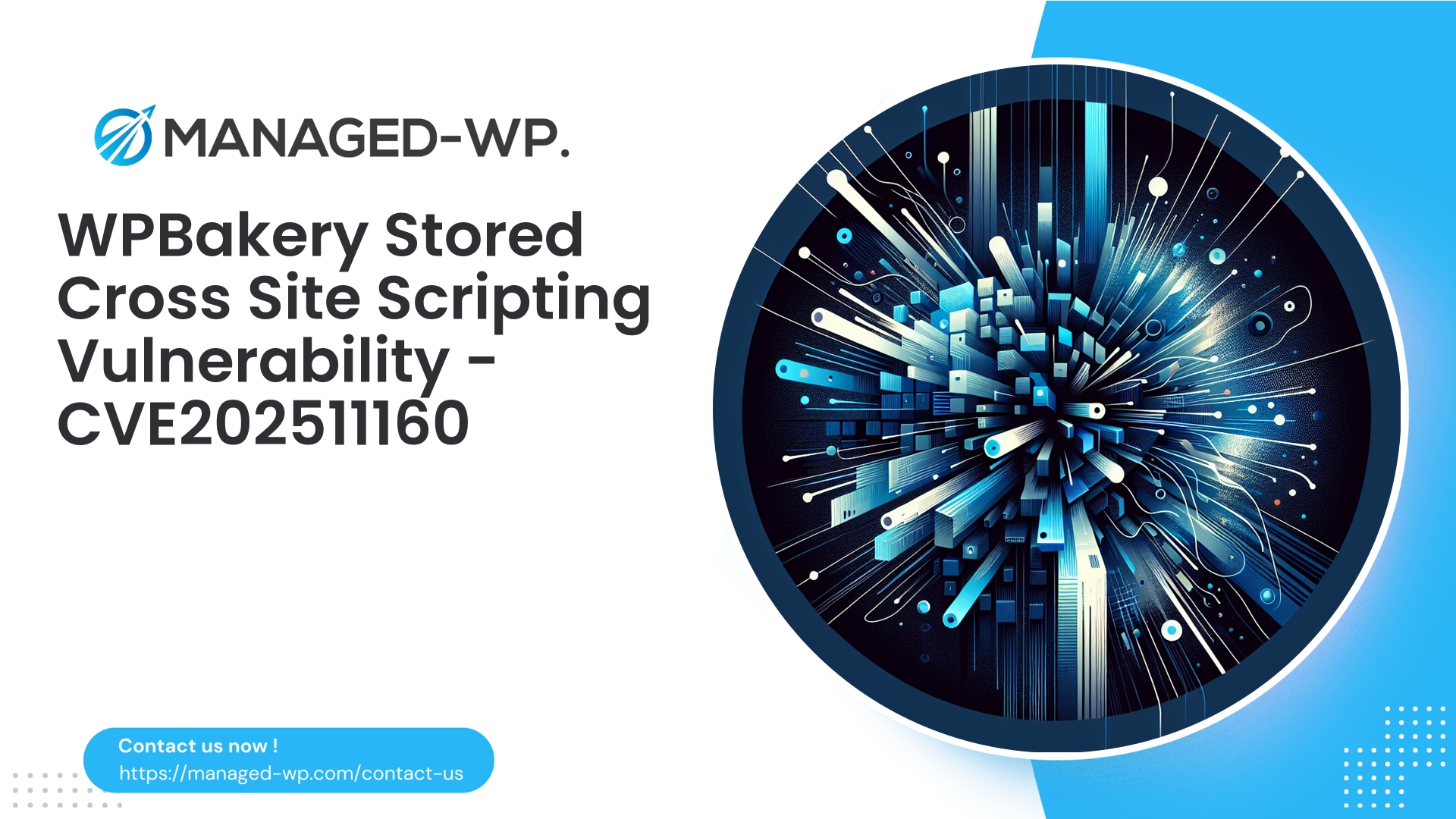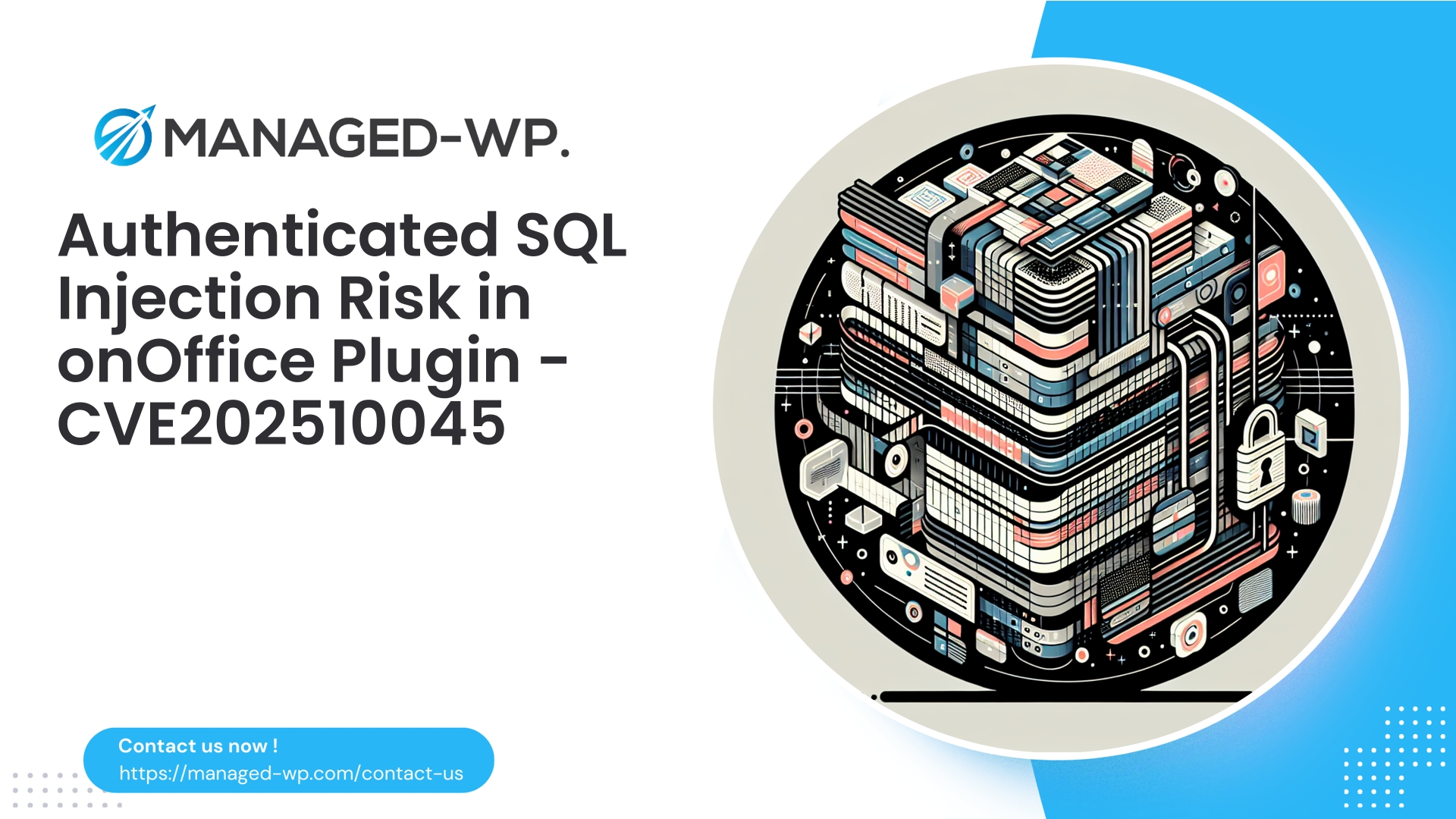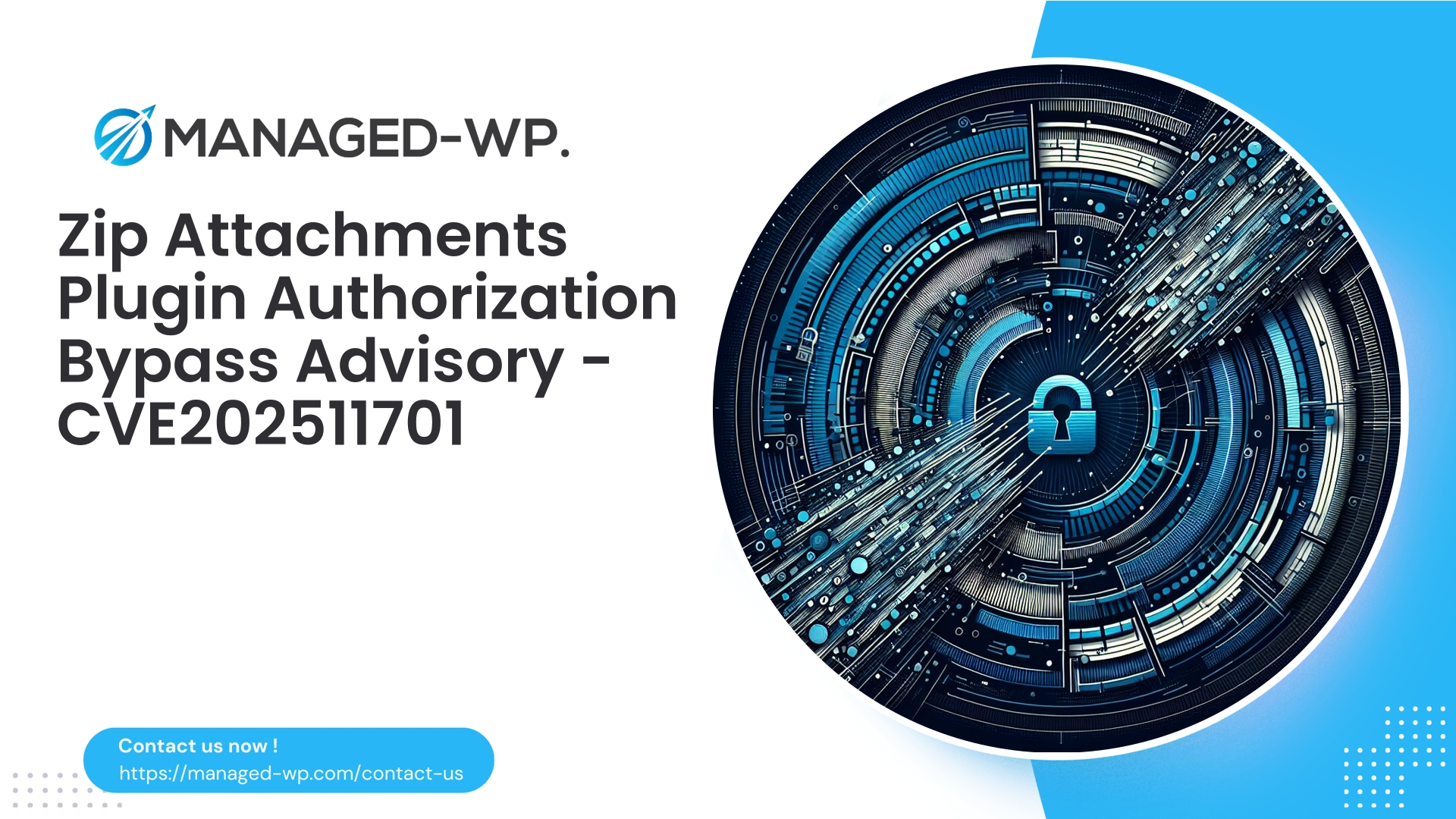| Plugin Name | WPBakery Page Builder |
|---|---|
| Type of Vulnerability | Stored Cross Site Scripting |
| CVE Number | CVE-2025-11160 |
| Urgency | Low |
| CVE Publish Date | 2025-10-15 |
| Source URL | CVE-2025-11160 |
WPBakery Page Builder ≤ 8.6.1 — Stored XSS Vulnerability in Custom JS Module (CVE-2025-11160): Essential Guidance for Website Owners
Introduction
A stored Cross-Site Scripting (XSS) vulnerability has been identified in the WPBakery Page Builder plugin, affecting versions up to and including 8.6.1, documented under CVE-2025-11160. This vulnerability exposes websites to risk by allowing attackers with contributor-level access to inject malicious JavaScript code that executes within visitors’ browsers. Given the widespread use of WPBakery as a page-building tool, and the frequent delegation of contributor privileges, this represents a significant threat if not promptly addressed.
As US cybersecurity experts at Managed-WP, we analyze such vulnerabilities with a sharp focus on both the technical mechanisms and the practical defense measures site owners must take immediately. This article provides a detailed breakdown of the vulnerability, potential impact, detection techniques, containment strategies, and actionable recommendations for mitigation including patching and web application firewall (WAF) rules to block exploitation.
Executive Summary
- Affected Software: WPBakery Page Builder plugin (≤ 8.6.1)
- Vulnerability Type: Stored Cross-Site Scripting (XSS) via custom JS module
- CVE Identifier: CVE-2025-11160
- Fix Available In: Version 8.7 (Update immediately)
- Privileges Required: Contributor or equivalent low-level editor access
- Risk Overview: Attackers who can create or edit page builder content may embed JavaScript payloads that run in visitors’ browsers, enabling cookie theft, session hijacking, silent redirects, or injection of malicious content.
- Immediate Mitigation: Upgrade to version 8.7+, restrict contributor access to custom JS features, scan and clean site content, and deploy WAF rules or virtual patching to block malicious script injections.
How This Vulnerability Works: A Clear Explanation
Stored XSS vulnerabilities occur when an application accepts and stores untrusted input—such as JavaScript code—without proper sanitization before presenting it to other users. In this scenario, the WPBakery Page Builder’s Custom JS module allowed contributors to save raw JavaScript code. That code would then be served to site visitors without any filtering, causing the malicious scripts to execute in their browsers under the site’s origin.
Crucially, exploitation requires only contributor-level permissions, commonly granted to guest authors or less-privileged users who can insert or modify page builder content, making this a tangible risk for sites with open content workflows.
Why Stored XSS Is a Serious Threat
Unlike reflected XSS, stored XSS persists on the server and automatically executes whenever a victim visits the affected page, without needing to click a crafted link. Attackers leverage this to:
- Steal session cookies, enabling account takeover (especially where cookie policies are lax)
- Redirect visitors to malicious websites unnoticed
- Inject unauthorized spam or SEO manipulation content
- Deploy browser-based cryptomining or ad fraud scripts
- Set up secondary attacks, including backdoor installations if higher privileges are later compromised
Understanding Impact & Severity
CVE-2025-11160 carries a moderate CVSS score (~6.5), but its real-world risk varies depending on factors such as:
- Presence of high-traffic pages utilizing custom JS
- Strength (or weakness) of user account security practices, including password hygiene and multi-factor authentication (MFA)
- Possibility that privileged users (editors, administrators) will browse affected content and become targets
Sites relying on contributors for content creation or editorial work must act promptly to prevent exploitation.
Immediate Remediation Steps
- Upgrade WPBakery Page Builder plugin to version 8.7 or later
- This is the definitive security fix; prioritize applying this update.
- If immediate upgrade is infeasible due to testing or deployment timing, implement the mitigations below.
- Restrict Access to the Custom JS Module
- Temporarily revoke contributor and similar role access to the functionality allowing custom JavaScript within the page builder.
- Use role-management or capability-editing plugins to remove this editing privilege from non-trusted users.
- Scan and Clean Site Content
- Search posts, pages, and postmeta fields for suspicious “ tags, JavaScript URIs, and event handlers.
- Use SQL and WP-CLI commands (detailed later) to identify potentially malicious content.
- Deploy WAF or Virtual Patching Rules
- Configure rules to block script injection patterns such as “, `onerror=`, or `javascript:` in POST and PUT requests where content is saved.
- Limit enforcement to non-admin users where possible to reduce false positives.
- Harden User Account Security
- Mandate MFA on all administrative and content-editor accounts.
- Rotate passwords for contributors and other users with editing rights, particularly if compromise is suspected.
- Review user accounts to disable or remove unknown or dormant users.
- Monitor Logs and User Activity
- Inspect access logs for anomalous POST requests to admin endpoints with suspicious payloads.
- Review editor activity to detect unusual content modifications.
- Incident Response if Infection Is Detected
- Consider temporarily isolating or taking the site offline if malicious scripts persist on critical pages.
- Remove malicious content from database and files, restoring from backups if needed.
- Perform comprehensive malware and backdoor scans.
- Engage professional assistance for complex compromises.
Detecting Stored XSS at the Content Level: Practical Guidelines
Search your WordPress database for patterns typical of malicious injected scripts:
- WP-CLI Example:
wp db query "SELECT ID, post_title FROM wp_posts WHERE post_content LIKE '%<script%' OR post_content LIKE '%javascript:%' OR post_content LIKE '%onerror=%' LIMIT 100;" - Direct SQL (Adjust prefix as needed):
SELECT ID, post_title, post_type FROM wp_posts WHERE post_content REGEXP '<(script|img|svg|iframe)[[:space:]>]' OR post_content REGEXP 'on(error|load|mouseover|click)=' LIMIT 500; - Scan postmeta fields (page builder module content):
SELECT meta_id, post_id, meta_key, meta_value FROM wp_postmeta WHERE meta_value LIKE '%<script%' OR meta_value LIKE '%javascript:%' OR meta_value LIKE '%onerror=%' LIMIT 500; - File system scanning:
grep -RIn --include="*.php" --include="*.js" --include="*.html" "<script" wp-content/ | head
Important Notes:
- Page builder content may be serialized; use appropriate tools to decode and inspect.
- Expect some legitimate inline scripts (e.g., analytics, widgets); focus on unexpected or unauthorized code.
Cleanup Checklist if Malicious Content Is Found
- Locate and remove the affected page builder modules or content entries containing malicious JS.
- Restore cleansed pages from known-good backups if necessary.
- Check for surreptitious redirectors or backdoors; inspect recently modified files and unfamiliar PHP scripts in the content directories.
- Rotate API keys and credentials potentially exposed by the compromise.
- Run malware scans post-cleanup to verify removal.
WAF and Virtual Patching Recommendations
While upgrading is the optimal solution, virtual patching via a properly configured Web Application Firewall (WAF) can reduce risk by blocking exploit attempts in the interim. Consider implementing rules that:
- Intercept POST/PUT requests to content save endpoints and block those containing suspicious script-like payloads.
- Target admin URLs such as
/wp-admin/post.php,/wp-admin/admin-ajax.php, and REST API endpoints/wp-json/wp/v2/*. - Allow bypasses for authenticated administrators to prevent disruption of legitimate editing.
- Detect not only plain text but also encoded variants (URL-encoded, base64, Unicode escapes).
Example WAF Rule Logic (Conceptual ModSecurity)
SecRule REQUEST_METHOD "(POST|PUT)" "chain,phase:2,id:100001,log,deny,msg:'Block XSS attempt - script or event handler in POST body'"
SecRule REQUEST_HEADERS:Content-Type "!(multipart/form-data|application/x-www-form-urlencoded|application/json)" "t:none,chain"
SecRule REQUEST_BODY "(?:<|%3C)(?:s|S)(?:c|C)(?:r|R)(?:i|I)(?:p|P)(?:t|T)\\b|on(?:error|load|mouseover|click)\\s*=" "t:none,t:urlDecodeUni,t:lower"
Notes:
t:urlDecodeUnidecodes various encoding schemes for better detection.- Complement with additional rules for
javascript:URIs and event handlers. - Tune rule scope to reduce false positives.
Additional WAF Example: Block REST API Abuse
SecRule REQUEST_URI "@beginsWith /wp-json/wp/v2/posts" "phase:2,chain,id:100010,log,deny,msg:'REST API XSS attempt'"
SecRule REQUEST_METHOD "POST" "chain"
SecRule &ARGS_NAMES "!@eq 0" "chain"
SecRule ARGS_NAMES|ARGS "(?:<(script)|on(error|load|click)|javascript:)" "t:urlDecodeUni,t:lower"
Notes:
- REST API increasingly handles content submissions; inspect payloads carefully.
- Apply user role checks when feasible to exclude trusted users.
Blocking Submissions from Low Privilege or Unauthenticated Users
Where possible, use WAF session data (cookies/JWT claims) to restrict script-like payloads to administrator users only, mitigating false positives while maintaining protection for lower-tier users.
Defense-in-Depth: Content Security Policy (CSP)
Implementing a strict CSP can reduce the impact of stored XSS by restricting execution of inline and external scripts. Recommended directives include:
- default-src ‘self’;
- script-src ‘self’ ‘nonce-<random>’ https://trusted.cdn.example;
- object-src ‘none’;
- base-uri ‘self’;
- form-action ‘self’;
Important Considerations:
- Test CSP implementations carefully as they can break legitimate inline scripts unless nonces or hashes are used.
- CSP complements patching and WAF; it is not a standalone fix.
WordPress Configuration Hardening Best Practices
- Follow the principle of least privilege; only trusted users should have page builder editing rights.
- Require strong passwords and two-factor authentication for all users with editing capabilities.
- Disable theme and plugin editing via WordPress admin by adding
define('DISALLOW_FILE_EDIT', true);to wp-config.php. - Keep WordPress core, themes, and plugins up-to-date, employing staged rollouts where necessary.
- Implement IP allowlisting for plugin or admin UI access if possible.
- Remove unused or obsolete plugins and themes regularly.
Logging and Monitoring Recommendations
- Maintain and review server access logs and PHP error logs, focusing on POST requests from low privilege users to admin endpoints.
- Configure WAF to forward suspicious activity logs to your SIEM or centralized logging system with relevant context.
- Utilize WordPress activity or content change monitoring plugins to trace content modifications.
- Schedule regular automated security scans to identify new indicators of compromise.
Forensics: Key Indicators Post-Attack
- Discovery of new or recently altered posts or pages containing inline
<script>tags - New admin or editor accounts created without approval
- Unexpected outbound network traffic or DNS lookups to suspicious domains
- Altered core or plugin/theme files containing obfuscated code
- New or anomalous scheduled tasks (cron jobs) that could sustain malicious payloads
Testing and Verification Recommendations
- Test plugin updates and WAF rules in staging environments before production deployment.
- After cleanup, re-run content search queries and scans to confirm removal.
- Verify site functionality and rendering across major browsers following CSP and WAF changes.
Developer Best Practices
- Never store unescaped or unsanitized user input capable of being executed as code.
- Use WordPress sanitization and escaping functions such as
sanitize_text_field(),wp_kses_post(),esc_js(),esc_html(), andesc_attr()consistently to validate inputs and escape outputs. - Restrict editing of code fields to trusted administrators, and consider requiring approval or applying sanitization when storing code snippets.
- Where feasible, use shortcodes with sanitized attributes in place of raw JavaScript blocks.
How Managed-WP Protects Your Site
Here at Managed-WP, we recommend a multi-layered defense strategy to mitigate risks from vulnerabilities like this:
- Prompt patching of vulnerable plugin versions to 8.7 or newer
- Where patching is delayed, enabling virtual patching rules that prevent injection of malicious scripts through page builder modules
- Limiting injection capability to administrators or approved IP ranges
- Providing granular forensic logging to identify affected content and responsible user accounts
- Ongoing monitoring to detect and block automated exploitation attempts
Introducing Managed-WP’s Free Protection Plan
Quickly Shield Your Site with Managed-WP’s Free Plan
To help site owners secure their websites immediately while patches are applied, Managed-WP offers a free plan that includes essential managed firewall protection. Our free tier delivers an always-on Web Application Firewall, unlimited bandwidth protection, malware scanning, and mitigation for OWASP Top 10 risks — enabling you to block attacks exploiting this and other vulnerabilities right now.
Get started here: https://my.wp-firewall.com/buy/wp-firewall-free-plan/
For enhanced automation, such as automatic malware removal, per-site blacklisting/whitelisting, monthly security reports, or auto virtual-patching, consider upgrading within the Managed-WP dashboard. However, the free plan is an effective early step to reduce risk while you complete remediation.
Operational Priorities and Timelines
- Immediate (0-24 hours):
- Upgrade WPBakery Page Builder plugin to 8.7 or later.
- If not feasible, restrict contributor access to Custom JS modules and apply WAF rules blocking script injections.
- Search for and remove any stored malicious scripts.
- Short term (1–7 days):
- Strengthen user account security with MFA and password rotation.
- Monitor access logs and editor activity closely.
- Mid term (1–4 weeks):
- Ensure all site instances are updated.
- Conduct thorough site audits for backdoors and unauthorized accounts.
- Review and tighten policies on content creation and use of custom JS.
- Long term (ongoing):
- Maintain automated vulnerability management, patching schedules, and security monitoring.
- Continuously tune and maintain WAF rules informed by observed traffic and false positive trends.
FAQ
Q: Can anonymous visitors exploit this XSS vulnerability?
A: No. Exploitation requires contributor-level access to insert or modify custom JS modules. Anonymous visitors cannot exploit this directly.
Q: Is removing the WPBakery Page Builder plugin a safer alternative to updating?
A: Removing the plugin eliminates the vulnerable attack surface if feasible without breaking site functionality. However, most sites depend on WPBakery for layout and content management. Updating to the patched version (8.7+) combined with access restrictions and WAF rules is the recommended approach. If you remove the plugin, verify no residual malicious inline scripts remain embedded in content.
Q: Can a WAF block all exploitation attempts?
A: No security control is foolproof on its own. WAFs are highly effective in reducing risks but must be combined with timely patching, sound access controls, and content scanning for comprehensive defense.
Summary: Recommended Immediate Actions
- Update WPBakery Page Builder plugin to version 8.7 or later without delay.
- Restrict contributor and similar user roles from accessing the Custom JS module if you cannot immediately update.
- Scan and clean all site content for stored malicious scripts using the provided SQL and WP-CLI queries.
- Implement multi-factor authentication and rotate credentials especially for users with suspected compromise.
- Deploy a managed WAF solution, such as Managed-WP’s free plan, to virtually patch and mitigate exploit attempts.
- Enable alerting on suspicious POST requests to admin endpoints to detect attempted exploitation.
Appendix: Useful Commands and Example Rules
SQL query to identify scripts in posts:
SELECT ID, post_title FROM wp_posts WHERE post_content REGEXP '(?i)<script|javascript:|on(error|load|click)=' LIMIT 500;
Sample ModSecurity rule snippet:
SecRule REQUEST_METHOD "(POST|PUT)" "phase:2,deny,id:100200,msg:'XSS payload detected in request body',log,t:none"
SecRule REQUEST_BODY "@rx (?i)(?:<\s*script\b|on(?:error|load|click)\s*=|javascript:|document\.cookie|eval\()" "t:urlDecodeUni,t:lower"
WP-CLI example to scan suspicious postmeta entries:
wp db query "SELECT post_id, meta_key FROM wp_postmeta WHERE meta_value LIKE '%<script%' OR meta_value LIKE '%onerror=%' LIMIT 200;"
Final Note from the Managed-WP Security Team
Stored XSS is a persistent and dangerous threat, especially in environments where contributors or external authors can edit content. Strong access controls, prompt patching, thorough content inspections, and robust virtual patching through WAFs are critical to minimizing your site’s exposure. For rapid deployment of protective measures, consider the Managed-WP free firewall plan to help block exploit attempts while you remediate.
— Managed-WP Security Team



















